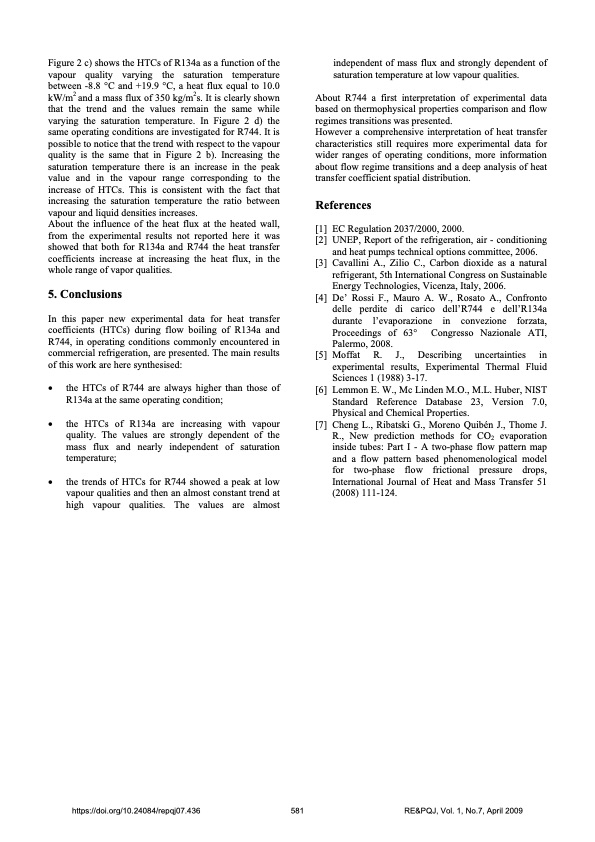
PDF Publication Title:
Text from PDF Page: 005
Figure 2 c) shows the HTCs of R134a as a function of the vapour quality varying the saturation temperature between -8.8 °C and +19.9 °C, a heat flux equal to 10.0 kW/m2 and a mass flux of 350 kg/m2s. It is clearly shown that the trend and the values remain the same while varying the saturation temperature. In Figure 2 d) the same operating conditions are investigated for R744. It is possible to notice that the trend with respect to the vapour quality is the same that in Figure 2 b). Increasing the saturation temperature there is an increase in the peak value and in the vapour range corresponding to the increase of HTCs. This is consistent with the fact that increasing the saturation temperature the ratio between vapour and liquid densities increases. About the influence of the heat flux at the heated wall, from the experimental results not reported here it was showed that both for R134a and R744 the heat transfer coefficients increase at increasing the heat flux, in the whole range of vapor qualities. 5. Conclusions In this paper new experimental data for heat transfer coefficients (HTCs) during flow boiling of R134a and R744, in operating conditions commonly encountered in commercial refrigeration, are presented. The main results of this work are here synthesised: • the HTCs of R744 are always higher than those of R134a at the same operating condition; • the HTCs of R134a are increasing with vapour quality. The values are strongly dependent of the mass flux and nearly independent of saturation temperature; • the trends of HTCs for R744 showed a peak at low vapour qualities and then an almost constant trend at high vapour qualities. The values are almost independent of mass flux and strongly dependent of saturation temperature at low vapour qualities. About R744 a first interpretation of experimental data based on thermophysical properties comparison and flow regimes transitions was presented. However a comprehensive interpretation of heat transfer characteristics still requires more experimental data for wider ranges of operating conditions, more information about flow regime transitions and a deep analysis of heat transfer coefficient spatial distribution. References https://doi.org/10.24084/repqj07.436 581 RE&PQJ, Vol. 1, No.7, April 2009 [1] [2] [3] [4] [5] [6] [7] EC Regulation 2037/2000, 2000. UNEP, Report of the refrigeration, air - conditioning and heat pumps technical options committee, 2006. Cavallini A., Zilio C., Carbon dioxide as a natural refrigerant, 5th International Congress on Sustainable Energy Technologies, Vicenza, Italy, 2006. De’ Rossi F., Mauro A. W., Rosato A., Confronto delle perdite di carico dell’R744 e dell’R134a durante l’evaporazione in convezione forzata, Proceedings of 63° Palermo, 2008. Moffat R. J., experimental results, Experimental Thermal Fluid Sciences 1 (1988) 3-17. Lemmon E. W., Mc Linden M.O., M.L. Huber, NIST Standard Reference Database 23, V ersion 7.0, Physical and Chemical Properties. Cheng L., Ribatski G., Moreno Quibén J., Thome J. R., New prediction methods for CO2 evaporation inside tubes: Part I - A two-phase flow pattern map and a flow pattern based phenomenological model for two-phase flow frictional pressure drops, International Journal of Heat and Mass Transfer 51 (2008) 111-124. Congresso Describing Nazionale uncertainties A TI, inPDF Image | Comparison of R744 and R134a

PDF Search Title:
Comparison of R744 and R134aOriginal File Name Searched:
436-mastrullo.pdfDIY PDF Search: Google It | Yahoo | Bing
CO2 Organic Rankine Cycle Experimenter Platform The supercritical CO2 phase change system is both a heat pump and organic rankine cycle which can be used for those purposes and as a supercritical extractor for advanced subcritical and supercritical extraction technology. Uses include producing nanoparticles, precious metal CO2 extraction, lithium battery recycling, and other applications... More Info
Heat Pumps CO2 ORC Heat Pump System Platform More Info
| CONTACT TEL: 608-238-6001 Email: greg@infinityturbine.com | RSS | AMP |